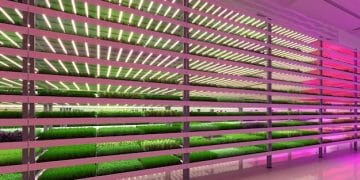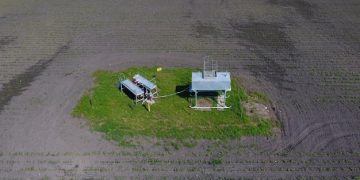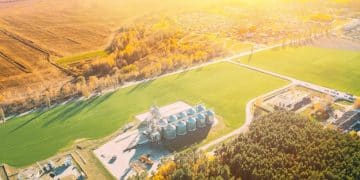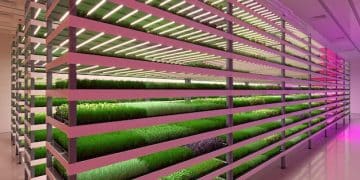Vertical Farming: Is It a Game-Changer for US Farmers?
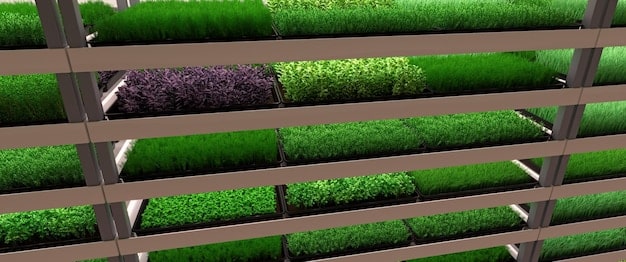
Vertical farming, with its innovative techniques and technological advancements, presents a promising, albeit complex, solution for US farmers looking to enhance productivity and sustainability in agriculture.
The agricultural landscape is constantly evolving, and with increasing demands on food production, farmers are seeking innovative solutions. New developments in vertical farming: is it a viable option for US farmers? has emerged as a potential game-changer. This article explores the latest advancements, challenges, and opportunities, helping you understand if vertical farming could be the future of agriculture in the United States.
Understanding Vertical Farming
Vertical farming is an innovative agricultural approach that maximizes crop production in limited spaces. Unlike traditional farming methods, vertical farming utilizes stacked layers in a controlled indoor environment, allowing for higher yields and reduced resource consumption.
This method is gaining traction, especially in urban areas, where land is scarce and the demand for fresh, locally-sourced produce is high. By understanding the principles and benefits of vertical farming, US farmers can explore new avenues for growth and sustainability.
Key Principles of Vertical Farming
Vertical farming relies on several fundamental principles to create an optimal growing environment. These principles include controlled environment agriculture (CEA), optimized lighting, and efficient resource management.
CEA involves regulating factors such as temperature, humidity, and CO2 levels to enhance plant growth. Optimized lighting often uses LED technology to provide the specific wavelengths of light that plants need. Efficient resource management includes recycling water and nutrients, reducing waste and environmental impact.
- 🌱 Controlled Environment: Precisely managed conditions for optimal growth.
- 💡 Optimized Lighting: LED technology tailored to plant needs.
- 💧 Resource Management: Recycling water and nutrients for efficiency.
- 🏢 Urban Integration: Bringing farming closer to consumers in cities.
By mastering these principles, farmers can create highly productive vertical farms that deliver consistent yields year-round, regardless of external weather conditions.
Technological Advancements in Vertical Farming
Technology plays a crucial role in the success of vertical farming. From automated systems to advanced monitoring tools, technological innovations are making vertical farms more efficient and cost-effective.
These advancements not only increase productivity but also reduce the need for manual labor, addressing labor shortages and enhancing the overall sustainability of farming operations.
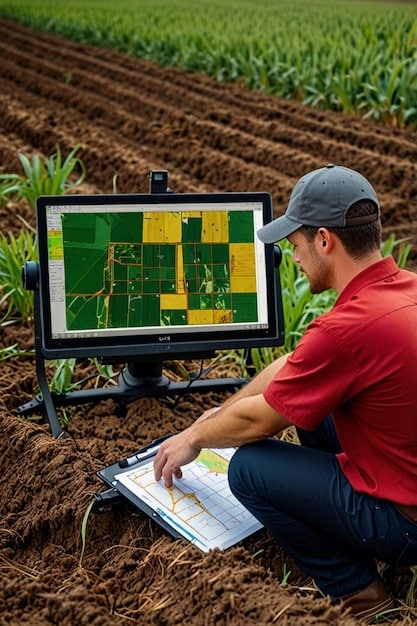
Automation and Robotics
Automation and robotics are transforming vertical farming by streamlining processes and reducing labor costs. Automated systems can handle tasks such as planting, watering, harvesting, and packaging with minimal human intervention.
Robots equipped with sensors and AI algorithms can monitor plant health, detect diseases, and apply treatments precisely, ensuring optimal growing conditions. This level of precision and efficiency is difficult to achieve with traditional farming methods.
Data Analytics and IoT
Data analytics and the Internet of Things (IoT) are providing vertical farmers with valuable insights into their operations. Sensors and IoT devices collect real-time data on temperature, humidity, light levels, and nutrient concentrations.
This data is then analyzed to identify patterns and optimize growing conditions. Predictive analytics can forecast yields, detect potential problems, and recommend corrective actions, helping farmers make informed decisions and improve their bottom line.
- 🤖 Automated Systems: Planting, watering, and harvesting with minimal labor.
- 📊 Data Analytics: Real-time data for optimizing growing conditions.
- 🌐 IoT Integration: Connecting sensors and devices for seamless monitoring.
- 💡 Predictive Analytics: Forecasting yields and detecting potential issues.
These technological advancements are driving the growth of vertical farming, making it a more attractive option for US farmers looking to modernize their operations and increase their competitiveness.
Economic Viability for US Farmers
While the technological advantages of vertical farming are clear, its economic viability for US farmers is a critical consideration. The initial investment costs can be high, but the potential for long-term profitability and sustainability is significant.
Farmers need to carefully evaluate the costs and benefits of vertical farming, considering factors such as energy consumption, labor costs, and market demand for locally-sourced produce.
Initial Investment Costs
The startup costs for vertical farming can be substantial, including the construction or retrofitting of indoor facilities, the installation of lighting, HVAC, and irrigation systems, and the purchase of automation equipment.
However, government incentives, grants, and financing options are available to help farmers offset these costs. Additionally, as technology advances and economies of scale are achieved, the costs of vertical farming are expected to decrease over time.
Operational Costs and Revenue Streams
Operational costs include energy consumption, labor, nutrients, and marketing expenses. Energy costs can be a significant factor, especially for indoor farms that rely on artificial lighting.
However, the use of renewable energy sources, such as solar power, and energy-efficient LED lighting can help reduce these costs. Revenue streams include the sale of fresh produce, subscription services, and partnerships with local restaurants and grocery stores.
- 💰 Startup Costs: High initial investment for facilities and equipment.
- 💡 Operational Costs: Energy, labor, nutrients, and marketing expenses.
- 📈 Revenue Streams: Sales of fresh produce, subscriptions, and partnerships.
- 🤝 Government Support: Incentives, grants, and financing options.
By carefully managing costs and diversifying revenue streams, US farmers can make vertical farming a profitable and sustainable venture.
Environmental Benefits and Sustainability
Vertical farming offers numerous environmental benefits, making it a more sustainable agricultural practice compared to traditional farming. Reduced water consumption, minimized land use, and the elimination of pesticides are key advantages.
These benefits align with the growing demand for environmentally responsible food production and can enhance the marketability of vertically farmed produce.
Reduced Water Consumption
Vertical farms use significantly less water than traditional farms. Through closed-loop irrigation systems and hydroponic or aeroponic techniques, water is recycled and reused, reducing water waste.
This is particularly important in regions facing water scarcity, where vertical farming can provide a more resilient and efficient approach to agriculture.
Minimized Land Use
Vertical farming maximizes crop production in a small footprint, reducing the need for extensive land clearing and deforestation. By growing crops in stacked layers, vertical farms can produce significantly more food per square foot compared to traditional farms.
This is especially beneficial in urban areas, where land is limited and the demand for local produce is high.
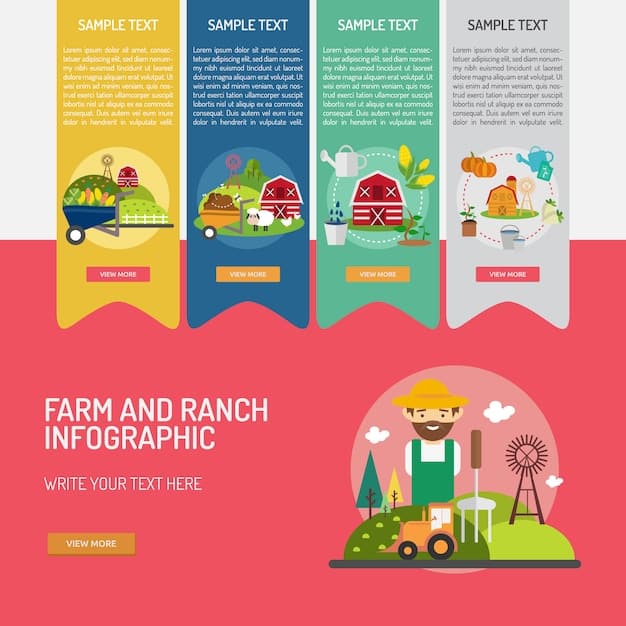
- 💧 Water Efficiency: Closed-loop systems reduce water consumption.
- 🏢 Land Use: Maximizing crop production in a small footprint.
- 🚫 Pesticide Elimination: Controlled environments reduce pest risks.
- 🌍 Reduced Carbon Footprint: Local production minimizes transportation.
The environmental benefits of vertical farming make it an attractive option for US farmers looking to adopt more sustainable practices and reduce their impact on the planet.
Challenges and Limitations
Despite its many advantages, vertical farming also faces several challenges and limitations that US farmers need to consider. High energy consumption, limited crop variety, and regulatory hurdles are among the key obstacles.
Addressing these challenges through technological innovation and supportive policies is essential for the widespread adoption of vertical farming.
High Energy Consumption
One of the primary challenges of vertical farming is the high energy consumption required to power artificial lighting, HVAC systems, and environmental controls. This can increase operational costs and offset some of the environmental benefits.
However, the use of renewable energy sources, such as solar power, and energy-efficient LED lighting can help mitigate this issue. Additionally, research is underway to develop more energy-efficient vertical farming systems.
Limited Crop Variety
Currently, vertical farming is best suited for certain types of crops, such as leafy greens, herbs, and strawberries. Growing a wider variety of crops, such as grains and root vegetables, presents technical and economic challenges.
However, ongoing research is exploring ways to expand the range of crops that can be successfully grown in vertical farms. Advances in lighting, nutrient management, and environmental control are paving the way for greater crop diversity.
- ⚡ Energy Costs: High consumption for lighting and climate control.
- 🥦 Crop Variety: Limited range of suitable crops.
- 🏛️ Regulatory Hurdles: Navigating permits and compliance.
- 💰 Scalability Issues: Challenges in expanding operations.
Overcoming these challenges is essential for realizing the full potential of vertical farming and making it a viable option for a wider range of US farmers.
Policy and Regulatory Landscape in the US
The policy and regulatory landscape plays a crucial role in shaping the future of vertical farming in the US. Supportive policies, incentives, and streamlined regulations can encourage the adoption of vertical farming practices.
Farmers need to stay informed about the evolving regulatory environment and advocate for policies that support the growth of the vertical farming industry.
Government Support and Incentives
Several government programs and incentives are available to support vertical farming in the US. These include grants, loans, tax credits, and research funding aimed at promoting sustainable agriculture and local food production.
Farmers can explore these opportunities to help offset the initial investment costs and operational expenses of vertical farming.
Regulatory Frameworks and Compliance
Vertical farms are subject to various regulations related to food safety, environmental protection, and building codes. Navigating these regulatory frameworks can be complex, and compliance is essential to ensure the safety and sustainability of vertical farming operations.
Organizations and industry associations are working to develop clear and consistent guidelines for vertical farming, making it easier for farmers to comply with regulations and operate successful businesses.
- 🏛️ Government Programs: Grants, loans, and tax credits for support.
- 📜 Regulatory Compliance: Food safety, environmental, and building codes.
- 🤝 Industry Associations: Developing guidelines and best practices.
- 📣 Policy Advocacy: Promoting supportive regulations for growth.
A favorable policy and regulatory environment is crucial for fostering the growth of vertical farming and making it a viable option for US farmers.
FAQ: Vertical Farming in the US
▼
Vertical farming is an innovative agricultural practice that grows crops in vertically stacked layers inside a controlled environment. It uses technologies like hydroponics, aeroponics, and aquaponics to optimize plant growth with minimal resources.
▼
The main advantages include higher crop yields, reduced water consumption, minimized land use, and the ability to grow crops year-round regardless of weather conditions. Additionally, it reduces the need for pesticides and herbicides.
▼
Leafy greens like lettuce, spinach, and kale, as well as herbs like basil and mint, are well-suited for vertical farming. Strawberries and other small fruits also thrive in vertical farming systems due to their compact size and quick growth cycles.
▼
Vertical farming has a positive environmental impact due to reduced water consumption, minimized land use, and the elimination of pesticides. By growing food locally, it also reduces transportation emissions associated with traditional agriculture.
▼
The main challenges include high initial investment costs, significant energy consumption for lighting and climate control, and the need for specialized knowledge and skills. Regulatory hurdles and scalability issues also pose challenges.
Conclusion
In conclusion, new developments in vertical farming: is it a viable option for US farmers? presents both significant opportunities and challenges. While the initial investment and energy costs can be substantial, the potential for increased yields, reduced resource consumption, and year-round production makes it an attractive option for innovative farmers. As technology continues to advance and policies become more supportive, vertical farming is poised to play a significant role in the future of agriculture in the United States, contributing to a more sustainable and resilient food system.

